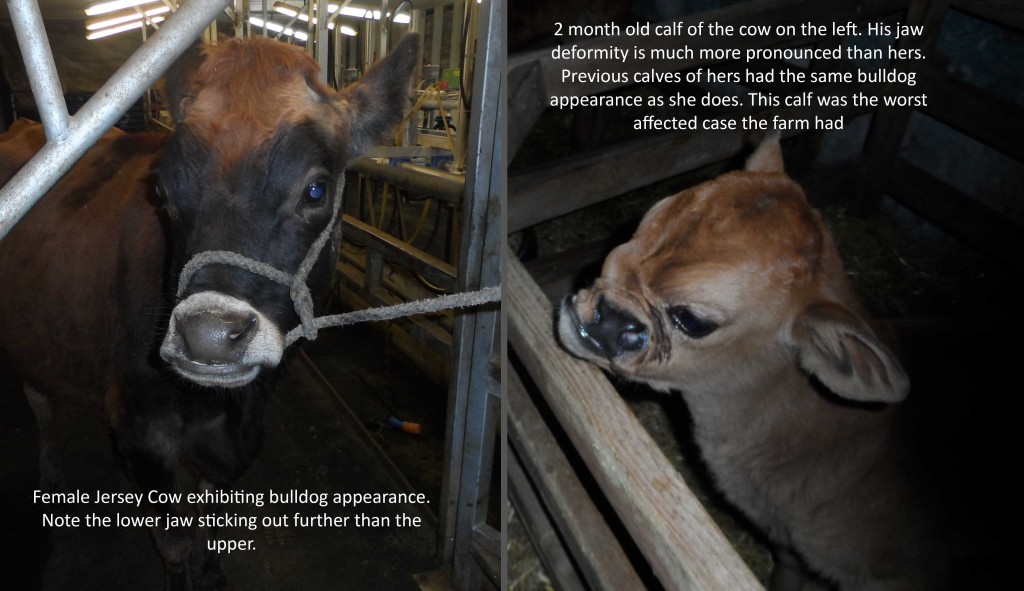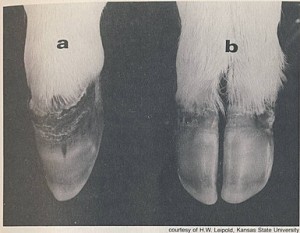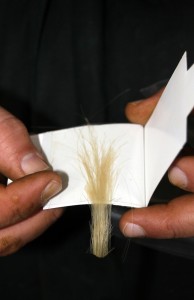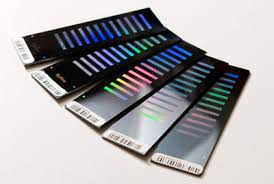What you need to know about congenital and genetic defects and what ICBF is doing to combat them in your herd

What is a congenital defect?
A congenital defect is a condition/abnormality in your calf that occurs at birth although it may have developed before the calf was even born. A congenital defect may be the result of infection during pregnancy, genetics, problems during the formation of the calf, chromosomal, exposure to toxins during pregnancy, or problems with in the intrauterine environment. While ICBF has an interest in all of these possibilities, we have the best chance to combat genetic defects and will be focusing on those.
Do all defects result in death of my animal?
No, not all defects cause the animal to die. Some animals can live a fairly normal life, but usually will have some deficits in gains or health, so even if the calf is alive it is best to report the defects. A good example can be found in a calf I saw in the USA. Its dam had a bulldog appearance (its lower jaw stuck out) and the farmer didn’t think anything of it because it was not that noticeable. He bred her to a sire who also had a bit of a jaw problem but his was also not very noticeable. Whatever was in the genes of these two animals cause a grossly defective calf. Although the calf was able to suckle the mother, it was not as efficient as a normal calf and thus would not ever achieve its full genetic potential.

How do I report a defect in a calf?
We have developed a survey powered by Surveymonkey which will ask you specific questions about your calf, starting at the head and moving towards the tail. This questionnaire is very comprehensive, but you can skip any questions that do not relate to the calf you’re reporting. Click here to go directly to the survey.
This information is very important to us for a number of reasons. First it will give us an accurate estimate of how many calves are born each year with defects, secondly it will allow us to identify sires that produce calves with greater numbers of defects, and lastly, if a defect cannot be related to a sire but has a geographic component, this data could serve as an early detection system for environmental toxins or new infectious agents.
Is there anything else ICBF is collecting in addition to the survey?
Yes! We are looking for photos of the deformed animal. The photos can be shared with veterinarians to get a diagnosis on calves that are not sent off for postmortems. Please e-mail all photos of animals with defects to [email protected]. If you do send the calf off for a postmortem we would appreciate access to the report so we can include the diagnosis into the data set. Lastly, we are working with Teagasc, AHI, and other resources to create a DNA sample repository for congenital defects. Eventually we would like to explore the possibility of identifying the causative mutation of any genetic defects by looking at the DNA of affected animals.

What is a causative mutation?
Some of these defects have a genetic component which can be passed down from the sire or dam to the progeny. Often times this defect is a result of one or more mutations in a gene which when identified a test can be developed for. Many of these defects are recessive traits which require both parents to have the faulty gene before you see the defect. If both parents carry the defective gene you have a 1 in 4 chance of having an affected calf, to keep this from happening the part of the gene that has the defect needs to be identified so that farmers can make better mating choices and thus reduce the possibility of having affected animals.
Are there any genetic defects we can test for now?
Yes! The IDBv2 chip has 86 defects we can test for right now. If your animals were genotyped before March 2014, they were probably genotyped with the IDBv1 chip which only covered 41 of the diseases. A list of the diseases will be available on here soon. In the mean time feel free to contact [email protected] if you have a question on a specific defect that you’d like to test for.

If I have a carrier animal, do I have to get rid of it?
Not if the trait is recessive, which many are. If you have a known carrier in your herd, they can still be very productive animals. You just have to choose who you mate the animal to a bit more carefully. When making breeding decisions, you’ll want to make sure that the carrier is not mated to another carrier so that your possibility of having an affected animal is zero. This is why genetics can be instrumental in removing a disease from the national herd, careful breeding can lead to eradication of the disease.
What do these defects look like?
Right now we’re working on creating a national database of congenital defects so that farmers can see what these defects look like. It is a slow process because there are lots of different defects out there. We are also working on a second database that will be linked to the IDB diseases where you can see a photo of the abnormality and get a brief description of the disease along with some extra information on the genes responsible for the disease.
